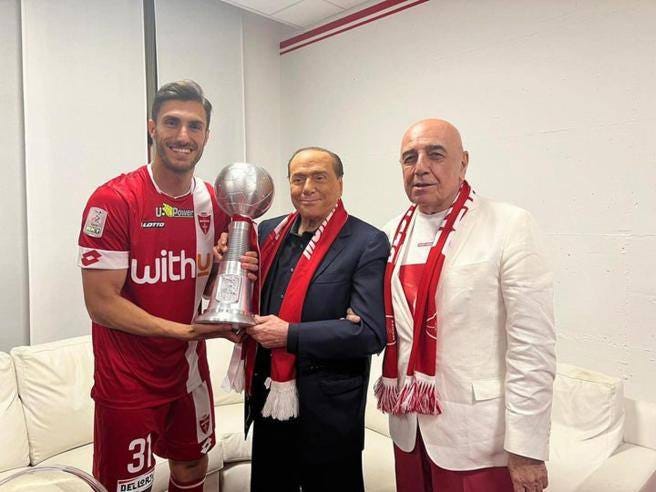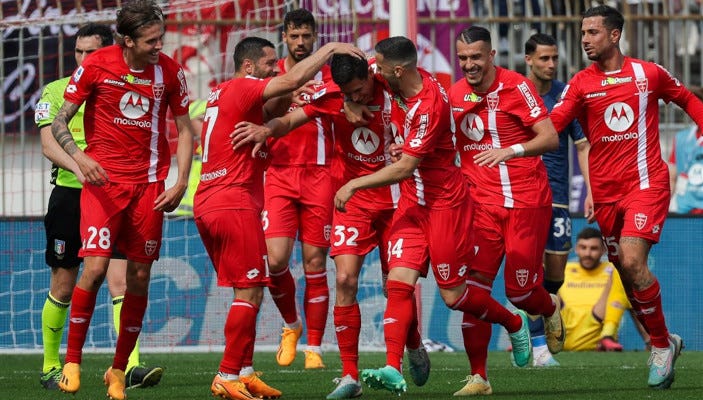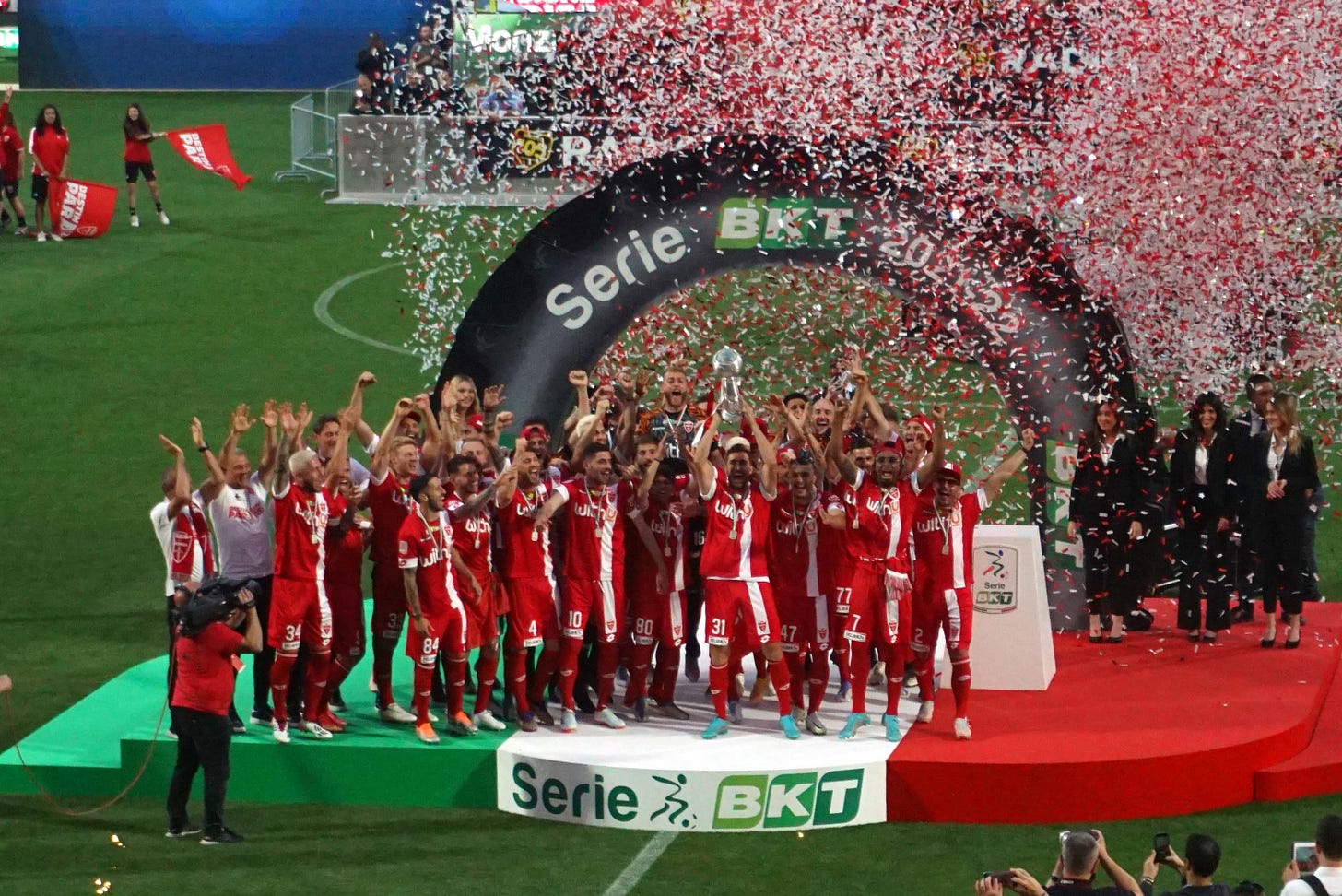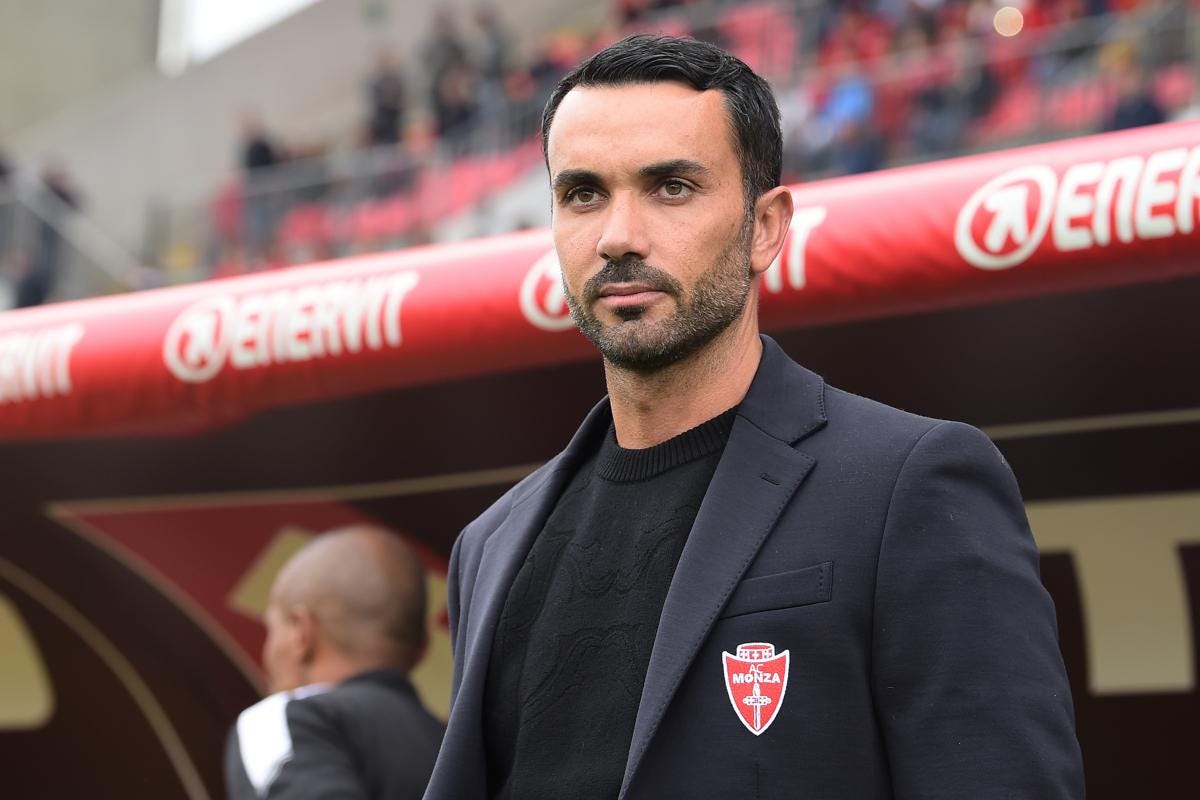It's not a Race, it's a Journey
AC Monza have been this season's surprise in Serie A. How has a team that was relegation candidates 6 games in propelled itself up the table? And what role does the legacy of a former Italian PM play?
When you hear “Monza”, I’m fairly sure you wouldn’t immediately associate the location with Football.
More often, with good reason, people associate the city of Monza, Lombardy, Italy, with its Grand Prix motor racing circuit, the Autodromo Nazionale di Monza, which has hosted the Italian Grand Prix in every single Formula One season barring one (1980). The track is the fastest on the calendar and consistently provides an entertaining race, even in the most one-sided of seasons. In recent years the race has played home to the most unlikely of victors, with Toro Rosso’s Pierre Gasly taking home his first and only win in 2020, and McLaren’s Daniel Ricciardo bringing his team their first race win in 9 years in 2021.
7km away from the Autodromo, at the Stadio Brianteo, another unlikely contender has been racing up the Serie A table and is giving us what seems like the most unlikely of seasons.
AC Monza was founded in 1912 as Monza F.B.C., and on multiple occasions in the 1970s came close to promotion to the Serie A. The club have fallen on awful hard times during the first two decades of the 21st century. The club entered a period of instability, changing owners twice in five years. Monza were relegated to the Serie C1 in 2001 and then, for the first time, to the Serie C2 (fourth division) in 2002. Amid Monza's financial troubles, on 31 December 2003 the city cut the supply of water and gas to their stadium after the club was unable to pay the bills. They declared bankrupt twice, in 2004 and 2015.
Following a 2018 takeover of the club, the Biancorossi returned to Serie B in 2020 after a 19-year absence, and last season they secured promotion to Serie A for the first time ever. Before their promotion, no Italian team had played more Serie B seasons (40) without playing in the Serie A.
OK, so let’s be honest here.
This is not quite the underdog story that it sounds like at first hearing.
Remember that takeover in 2018 that I mentioned? The one that triggered Monza’s rapid ascent? Well this was bankrolled by Silvio Berlusconi.
If you haven’t heard of Berlusconi before now, he was Italian Prime-Minister three times between 1994 and 2011 but has dominated public life for far longer, as a businessman and media magnate and through his ownership of AC Milan. His career has also been dogged by scandal and legal woes, which recently were focused on proceedings relating to his notorious “Bunga Bunga” sex parties.
(An… *interesting* Wiki on those here)
Berlusconi bought AC Monza through his holding company Fininvest in 2018, after selling AC Milan to a Chinese investment management company for about €520 million. Silvio’s brother, Paolo, is the club president and Silvio’s long-time collaborator Adriano Galliani the vice-president and CEO.
For Galliani, this is a dream. He was the man who persuaded Berlusconi to return to football. Despite all the time he spent in charge of making AC Milan one of the best clubs in world football, Monza was always his club. “I was born in Monza,” Galliani told Sky Sports at the start of the season. “My mother was from Monza. She took me to see matches when I was a child. I was one of the owners from 1975 to 1985 and for four consecutive years in that period we came within touching distance of Serie A.”
That was as close as they came until Berlusconi arrived. “The new adventure,” as Galliani has called it. At 78, he is seven years younger than the owner but this has reinvigorated him. “I feel like Ulysses returning to Ithaca.”
It’s an amazingly apt turn of phrase. Not sure if you’ve read The Odyssey, but as a qualified Classical Studies teacher, let me give you a little lesson.
The Odyssey tells the story of Ulysses (or Odysseus as many would know him), a Greek Hero returning home from the Trojan War. On his journey home from this 10 year long war, Ulysses runs into a myriad of obstacles, monstrous beings, and beautiful women that he spends several years cheating on his wife with, before he returns home, 20 years after leaving.
When Ulysses returns home to Ithaca, he finds out that his wife, Penelope (rightfully as she hasn’t heard from him in 20 years) believes he is dead. There is now a crowd of 108 suitors set up in his palace, all aiming to persuade Penelope to give them her hand in marriage, so that they can become the new King of Ithaca.
Ulysses, disguised as a dirty old beggar, infiltrates the palace, sets up a trap for the suitors with his son Telemachus. Under Telemachus’ advisement, Penelope maneuvers the suitors into competing for her hand in an archery competition using Ulysses' bow. The man who can string the bow and shoot an arrow through a dozen axe heads would win (Trick being that this bow could only actually be stringed by Ulysses). Odysseus takes part in the competition, and he alone is strong enough to string the bow, making him the winner. He then throws off his rags and, with his son, kills every single suitor in the palace.
Much like the mythical Greek hero, AC Monza have taken on the guise of the underdog, the poor, helpless beggar with no chance of dominating the competition, knowing full well that they have everything they could possibly need to succeed.

Monza have been able to outspend all of their rivals on the climb up from Italy’s third tier. Italian football finance website calcioefinanza.it calculated Fininvest’s total investment in reaching Serie A at €116m, adding up the initial cost of purchasing the club with losses on the balance sheet since.
But as the iconic
seems to constantly try to remind me when we’ve argued on Twitter recently, money can also be spent poorly.Galliani’s connections and transfer market experience were essential. At Milan he was nicknamed ‘The Condor’, a reference, as he tells it, to how he would swoop in like a bird of prey and snatch up a deal in the final days of each transfer window.
Galliani had a whole system back then, predicated on his belief that top clubs would always get themselves in a bind adding too many players during transfer windows, meaning other players would be available as bargains. He made a point of being sure that Milan’s sales and major purchases were always done as quickly as possible when a window opened, leaving him time to sit and wait for somebody else to panic.
The challenge at Monza has been a different one. At Milan, Galliani was mostly tweaking a successful side. Here, Galliani has built and rebuilt, obsessed with raising the level of the team.
Monza have relied heavily on loans with triggers that can make them into permanent deals: reaching the playoffs, securing promotion or, this season, avoiding relegation.
Upon reaching Serie A, Galliani tipped the old Condor model on its head, rushing to add high level know-how. Matteo Pessina and Stefano Sensi were signed in July, two players with Champions League experience and a combined 22 previous appearances for the Italian national team. So was Gianluca Caprari, a winger and forward who had scored 12 Serie A goals for Verona the season before.
The recruitment continued into early August, Pablo Mari arriving on loan from Arsenal, Andrea Petagna from Napoli and Marlon Santos from Shakthar Donetsk. For a team making its first appearance on Italy’s highest stage it was quite an arrival.
Early results were disappointing for the newly promoted club, especially considering a net spend of €46m according to TransferMarkt. Monza lost their first five matches and drew the sixth, then fired manager Giovanni Stroppa – the man who had led them up from Serie B. They were bottom of the league on 1 point.
Here is where Monza deviated from their usual practices. They decided to promote from within. Youth team coach Raffaele Palladino was promoted to manager, and what a promotion it has turned out to be. "It was a Monday morning, I was preparing for my team's usual training ," Palladino told DAZN.
“It's early in the morning and I get a call from Adriano Galliani: "In my opinion, you must be the coach of the first team. I'm going to ask Silvio, we meet tonight at Arcore." And then he hung up. Just like that. We went to Berlusconi, the adrenaline in me started to rise, and they decided to gift me with their trust. I was very moved.”
The next game was against Juventus. Monza won 1-0, with one of their Serie B holdovers, Christian Gytkjær, scoring the only goal. Palladino — à la Will Still12 — had not even formally begun studying for his Uefa Pro Licence yet, but had already claimed a win over Italy’s most domestically successful side.
Monza won the next two games, then lost a few, then picked up another pair of wins before the World Cup, clear improvement from that catastrophic start.
Berlusconi made a crass promise that he would deliver his players “a busload of prostitutes” if they could beat one of the big teams, later insisting that it had only been “locker-room joke”, even though he said it during an on-camera presentation to sponsors at a formal dinner. Monza drew 2-2 with Inter then won 2-0 away to Juventus. Wonder if he kept the promise.
Palladino had confessed his own surprise when beating the Bianconeri in September, but this time he had come with a plan, and it was executed to perfection. He has cited Gian Piero Gasperini as one of his biggest coaching inspirations, and his Monza team plays with a similar intensity to Atalanta, pressing the ball aggressively, engaging in one-on-one duels, setting a high defensive line.
Palladino met Marcelo Bielsa at Coverciano — Italy’s University of Football — a few months back, the former Leeds coach hearing about his promotion at Monza and seeking him out to offer him encouragement and ideas. “I’ve taken a lot of ideas from him,” he said. “He always talks about ‘gambeta’, dribbling. That is the essence of football.”
He didn’t abandon everything the team did under Stroppa but instead tweaked and shifted the team around to better suit what he saw as their main strengths.
In their first six matches Stroppa had strictly used a 3-5-2. The Biancorossi had set out their stall from the beginning. They weren’t just here to take part. They wanted to play positive football in their first Serie A season, especially with the heavy investment.
However, Stroppa’s side was heavily ineffective. They averaged 0.50 goals per 90 from 1.00 xG per 90, while defensively, they conceded 2.33 goals per 90 from 2.11 xGA. These were extremely worrying numbers, and it was clear something had to change.
Palladino immediately resorted to a 3-4-2-1, a formation which provides extreme balance in all areas of the pitch. Without much time to prepare, this seemed like the ideal choice for the 38-year-old. It instantly proved successful, and after a few matches, Monza had finally turned positive football into effective football.
Under Palladino, Monza are scoring 1.22 goals per 90 from 1.21 xG per 90. The defensive security Palladino has introduced is even more impressive. At one point in the season they were conceding only 0.89 goals per 90 from 1.01 xG, less than a goal per game. That, over time, has mellowed out to 1.21 from 1.28 xG, which still ranks them amongst the best defences in Serie A.3
The structure which Raffaele has resorted to is a big factor behind their success, and it is key to the way they play. The natural characteristics of some players have caused this to look like a 3-4-3 or a 3-4-1-2 at times, but the 3-4-2-1 is always at the core of their organisation.
The three centre-backs are at the base of their structure in possession. Monza have multiple options at the back, and their young manager has tried everyone out there, but Pablo Marí, former Arsenal player, is the most significant of the lot. Carlos Augusto has been the left wing-back. Patrick Ciurria has been the biggest surprise, with the former centre-forward now playing as a right wing-back under Palladino. He’s notched up 6 goals (tied top scorer) and 6 assists this season, crashing into the box with direct, penetrating runs and carries that send opposition defenders into a panic, though he has been known to cut inside and rifle one at goal also.
In the middle, the double pivot is usually formed by Sensi and Rovella, but there are many alternatives. Ahead of them, Matteo Pessina and Gianluca Caprari form a truly scary attacking midfield duo.
Up top, 24-year-old Dany Mota has been the go-to. The Portuguese centre-forward is very comfortable with dropping deep and participating in possession. With two advanced midfielders in front of him, he is able to take advantage of holes in the midfield created by them.
Defensively, the majority of their actions are concentrated in the half-spaces and wing channels. They like to force the opposition wide and overwhelm them against the touchline. Additionally, their defensive territory does not begin extremely high, highlighting their inclination towards a mid-to-high block instead.
Their defensive organisation begins in that block, but this structure never truly has a set shape. They’re consistently fluid in their behaviour and positioning, being very man-to-man oriented. They begin in their 3-4-2-1, with a box shape in the midfield and either wing-back pushing up high.4
The midfield works in pairs to press either side. This way they can remain balanced and quickly get to either side. In the instance below, the double pivot shifts to the left side as Rovella jumps on Salernitana’s player. Pessina tucks in and picks up the nearest midfielder. On the opposite side, the advanced duo pick up the remaining players.
Monza are right now, a team that still has plenty of flaws but are still finding ways to win thanks to good coaching that allows players to find themselves in the right spots at the right times. The sample size of games is so large now that nobody can claim their position in the league is a fluke.
A couple of months ago, Palladino gave an interview to Corriere dello Sport in which he shared a wish that more teams would give young coaches a chance. “I think above all that Italian football needs to have a bit more courage,” he said. “You learn by messing up sometimes.”
Palladino is yet to seriously mess up. Taking Monza over when they were dead last, they’re now placed 8th in the table, the best of the rest behind Italy’s usual characters. Monza secured their survival with six games to play. No other newly-promoted side has avoided relegation with as many as six games left to play since the 20-team format came into play in 2004-05.
It’s hard to root for a team that’s had so much outside money pumped into it by a figure as truly disgusting as Silvio Berlusconi, even if he was convinced by a local lad in Galliani wanting to give back to the area he grew up in.
If this venture feels like two men fighting to feel relevant again, aching for their “Odyssey” to continue, despite their increasingly old age and ill health, that is not the sense felt in Monza. At first, signings like Mario Balotelli seemed like they were just throwing away money, but that perception is changing.
Delve deeper and a lasting legacy is the goal. Infrastructure is in place for the long term. The stadium has been expanded with naming rights sold and executive boxes added to increase commercial revenue, and there are plans to extend it even further. There is a lighting system that only Juventus can match in Serie A. The training ground has been renovated with a state-of-the-art 4G pitch installed.
The belief is that Monza can become an aspirational brand, aided by links to Formula One and high-end fashion. In 2021, Roberto Cavalli became the club’s official fashion partner. The famous Monza race-track logo now adorns the back of the team’s shirts.
There are attempts to bring in a young support base through innovative and traditional methods. They are among the first clubs in Italy to launch an esports team, and Children in the city also receive a Monza-branded pencil case on their first day of school.
Back in Ancient Rome, the rich patricians would donate money to their city/town for them to build statues, or baths, or amphitheatres. The only terms placed upon these donations were that when these major civic projects were built, the names of the patricians would be written in large lettering in a prominent place that everyone could see. This is the project Galliani and Berlusconi are chasing. Something they can place their names upon, so that they may be forever remembered.
For this to happen, everything has to be done properly. Galliani told the Monza players at the beginning of the season, "It took us 110 years to reach Serie A, we cannot leave after 12 months.”
“Serie A is a dream that has come true, but it is not the end of the journey for Monza. We are building a competitive team, which can play permanently in Serie A in the coming years.”
“Last year they told me it was bad luck to say we had to go to Serie A and instead it didn't bring bad luck. It is right to dream, but with balance. As a goal, however, I set myself the target of 10th place. We won’t ever talk only about avoiding relegation.”
Right now, it seems Galliani underestimated even his own ability to build a club. With 2 games left, here’s how the Serie A table sits.
No matter how this season ends, make no mistake.
For AC Monza, this is just the beginning.
Did You Know: Will Still lead Reims to an 19-game unbeaten run in all competitions this season! At 30 years old, he’s the youngest manager in Europe’s top five leagues 🤩 Reims had to pay a £22,000 fine each time Still manages because he doesn’t have his UEFA Pro license 😅 What an incredible story 👏🏼
Sorry, I had to.
Graphics courtesy of totalfootballanalysis.com







